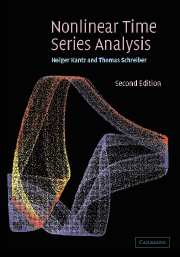Book contents
- Frontmatter
- Contents
- Preface to the first edition
- Preface to the second edition
- Acknowledgements
- I Basic topics
- II Advanced topics
- 9 Advanced embedding methods
- 10 Chaotic data and noise
- 11 More about invariant quantities
- 12 Modelling and forecasting
- 13 Non-stationary signals
- 14 Coupling and synchronisation of nonlinear systems
- 15 Chaos control
- A Using the TISEAN programs
- B Description of the experimental data sets
- References
- Index
14 - Coupling and synchronisation of nonlinear systems
Published online by Cambridge University Press: 06 July 2010
- Frontmatter
- Contents
- Preface to the first edition
- Preface to the second edition
- Acknowledgements
- I Basic topics
- II Advanced topics
- 9 Advanced embedding methods
- 10 Chaotic data and noise
- 11 More about invariant quantities
- 12 Modelling and forecasting
- 13 Non-stationary signals
- 14 Coupling and synchronisation of nonlinear systems
- 15 Chaos control
- A Using the TISEAN programs
- B Description of the experimental data sets
- References
- Index
Summary
The reason for the predominance of scalar observation lies partly in experimental limitations. Also the tradition of spectral time series analysis may have biased experimentalists to concentrate on analysing single measurement channels at a time. One example of a multivariate measurement is the vibrating string data [Tufillaro et al. (1995)] that we use in this book; see Appendix B.3. In this case, the observables represent variables of a physical model so perfectly that they can be used as state vectors without any complication. In distributed systems, however, the mutual relationship of different simultaneously recorded variables is much less clear. Examples of this type are manifold in physiology, economics or climatology, where multivariate time series occur very frequently. Such systems are generally quite complicated and a systematic investigation of the interrelation between the observables from a different than a time series point of view is difficult. The different aspects which we will discuss in this chapter are relevant in exactly such situations.
Measures for interdependence
As pointed out before, a first question in the analysis of simultaneously recorded observables is whether they are independent.
Example 14.1 (Surface wind velocities). Let our bivariate time series be a recording of the x-component and the y-component of the wind speed measured at some point on the earth's surface. In principle, these could represent two independent processes. Of course, a more reasonable hypothesis would be that the modulus of the wind speed and the angle of the velocity vector are the independent processes, and hence both x and y share some information of both.
Information
- Type
- Chapter
- Information
- Nonlinear Time Series Analysis , pp. 292 - 303Publisher: Cambridge University PressPrint publication year: 2003
Accessibility standard: Unknown
Why this information is here
This section outlines the accessibility features of this content - including support for screen readers, full keyboard navigation and high-contrast display options. This may not be relevant for you.Accessibility Information
- 1
- Cited by
